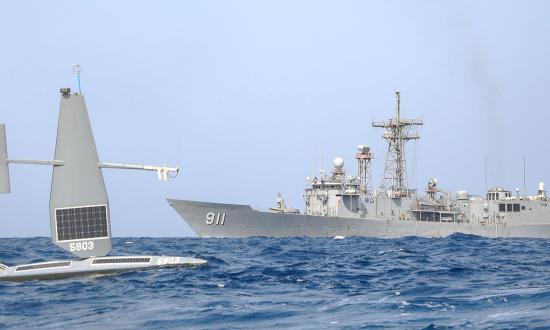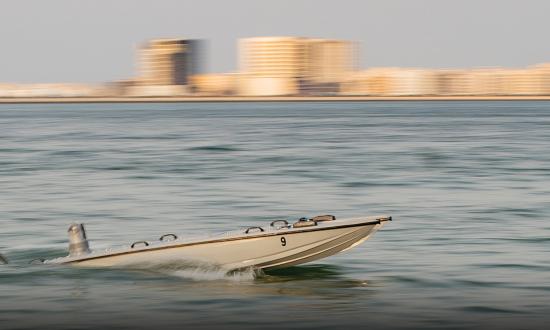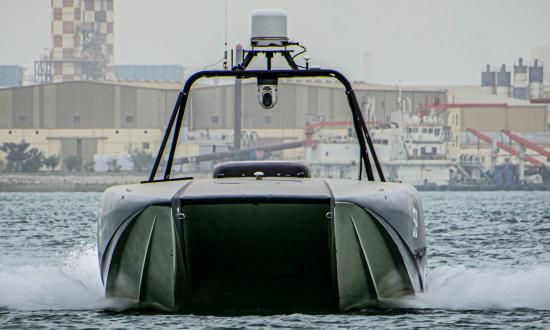In early April, the Navy announced it was moving its focus of experimentation for unmanned platforms to its Fourth Fleet, which is headquartered in Mayport, Florida, and operates largely in the Caribbean and the South Atlantic. This year’s unmanned experimentation effort will occur during the joint, international, UNITAS 23 exercise this summer and will include nations from across the region. The international exercise will continue the experiments that have been ongoing for the past several years both in the Arabian Gulf, where the U.S. Fifth Fleet did a similar string of international unmanned platform experiments under the leadership of Task Force 59, and before that in the southern Californian operations area under the direction of Navy Surface Development Squadron ONE. All three of these examples suggest a strategic assumption that the Navy can test game-changing capabilities in front of the world and yet still create the conditions for a technical leap-ahead. This is a mistake. To make the most of what unmanned and autonomous capabilities promise the warfighter, the Navy needs to take a lesson from the past and create a research, development, and prototyping test range on par with the Air Force’s fabled Area 51. To create the fleet of tomorrow with decisive capabilities, the Navy needs an unmanned “Area 52” where it can build and test breakthrough capabilities away from the prying eyes of competitors.
In 2022, the Navy sent four of its unmanned surface vessels to participate in its largest international exercise in the waters off Hawaii and San Diego. Twenty-six other nations participated, and China was not one of them. However, that did not stop the People’s Liberation Army Navy from sending an intelligence gathering ship to surveil the exercise and learn what it could. In 2022 and 2023, the United States and its partners in the Middle East conducted large exercises focused on unmanned and autonomous platforms with great apparent success. Again, foreign adversaries showed up not only to observe the operations and learn what they could about the United States’ most cutting-edge naval capabilities, but also seized one of those assets. Given that the Caribbean and the South Atlantic are monitored closely by Cuba, Venezuela, and Brazil—countries that have increasingly played host to Russia, China and even Iran—and are home waters of some of the largest criminal drug cartels on the planet, it would be foolish to think that advanced unmanned-autonomous capabilities tested in the region under the Navy’s Fourth Fleet would not be quickly compromised or even seized.
publicly. This Sea Hunter unmanned surface vessel participated in the international Rim of the
Pacific Exercise in 2022. (U.S. Navy/Tyler Fraser)
Such attempts at espionage should be expected. The United States has traditionally been the most technologically innovative nation in the world when it comes to its defense. The U.S. military has made a practice in the post-Vietnam era of investing in advanced capabilities rather than pursuing the sheer numbers associated with raw capacity. U.S. adversaries—including China, Russia, Iran, and North Korea—have systematically attempted (and often succeeded) to steal U.S. technology, reverse engineer it for themselves, and thus shorten their development time. The classic example of this phenomenon is the extent to which the Soviet Union went to obtain the secrets behind first the atomic bomb, then the hydrogen bomb, and finally guided missiles. It took the Soviet Union just four years after the first U.S. nuclear test at Los Alamos to detonate their first atomic bomb; then just three years after the first U.S. hydrogen bomb test, the Soviets tested their first fusion weapon in late 1952. Ultimately, the Soviets were able to overtake the U.S. in some critical national security technologies because the United States had not appropriately safeguarded its own innovations.
Properly developed and safeguarded, unmanned/autonomous capabilities could provide war-altering breakthroughs of the same magnitude as those which accompanied the advent of stealth and precision-guided munitions. Not only could unmanned/autonomous platforms extend the range of present sensors and provide additional offboard weapons magazines to supplement manned ships, but these new air, surface, and subsurface platforms could operate beyond the limits of human bodies and at speeds of function and decision-making that exceed human capacity. Lastly, they could extend U.S. military lethality into enemy territory without risking American lives. All told, whoever masters not only the development and design of unmanned/autonomous platforms but also the most effective concepts of operations to employ them will have a significant advantage on any future battlefield—an advantage that can be sustained if properly safeguarded. But, and this is the crucial point, the U.S. will not be able to create and maintain that advantaged trade space if it tests the most important innovations in front of allies, friends, and adversaries. This is why testing in the Fourth Fleet area of operations is strategically unwise. Instead, the Pentagon should take a lesson from the past and develop a new test range for unmanned/autonomous platforms much as it did in the past with its most advanced aviation projects.
Late in 1953, Lockheed’s legendary aircraft designer, Kelly Johnson, approached the Air Force with a design for a high-altitude surveillance aircraft. The Air Force reached out to the CIA, the plane’s other natural customer, and between them they let a contract to Lockheed’s “Skunk Works” team to build twenty aircraft that came to be known as the U-2 Dragon Lady. Neither the Air Force nor the CIA wanted the aircraft to be test flown from an Air Force base, so Johnson sent his company pilot out to survey several potential test sites. He found a dry lake north of Las Vegas within one of the Atomic Energy Commission’s test ranges and requested its use. On the map that test range was denoted as “Area 51,” and hence a legend was born. Johnson’s desire was to test his new aircraft where others could not see its activities, and that’s what he and Skunk Works did.
at Area 51 for decades. The Navy needs to develop and test its most capable unmanned and
autonomous platforms in a similar test area, out of view of adversaries.
(Public domain image)
During the succeeding decades, other aircraft, to include the SR-71 Blackbird and the F-117 Nighthawk, also emerged from the site. If the Navy wants to capitalize on all the advantages unmanned/autonomous platforms can offer, then it should look to establish a new range in which to research, develop, prototype, and test new air, surface, and subsurface unmanned systems and concepts of operations. Fortunately, there is an ideal location for just such a test range.
Lake Michigan is the fourth largest lake in the world by volume. It stretches just over 300 miles long and about 120 miles wide. Unlike the other four Great Lakes, all of Lake Michigan lies within U.S. territory, and while there is a diplomatic requirement to consult with the Canadians regarding military operations on the lake, there is historic precedent for such operations: during World War II, the U.S. Navy qualified most of its new aviators on two paddle-wheel aircraft carriers operating on the lake. The Chippewa Basin’s 920-foot depth provides ample room for unmanned underwater testing. For unmanned aviation development and testing, there is already an FAA-designated restricted military airspace over the lake, R-6903, where Air National Guard aircraft from the four adjoining states (Indiana, Michigan, Wisconsin, and Illinois) operate. For more than a decade, the Navy has conducted initial sea trials for its littoral combat ships within Green Bay and has gained experience performing surface operations in and around the established normal lake traffic. Finally, the Navy and the broader joint force is already present in the region, and there is ample room for enlargement.
concepts for naval unmanned/autonomous platforms. (NOAA)
Naval Station Great Lakes, established by President Theodore Roosevelt in 1905, is in Illinois, some thirty miles north of Chicago. Today its “bootcamp” marks the beginning point in every U.S. sailor’s naval career. The base also has a sea-walled boat basin along with adjacent buildings that could be repurposed to provide maintenance and support for Navy watercraft, including prototype unmanned surface and subsurface craft.
Experimental unmanned aircraft could be home based in the region at the Virgil Grissom Joint Air Reserve Base, located near Peru, Indiana, just ninety miles from Lake Michigan. Grissom is a former Cold War-era Strategic Air Command bomber base. Today it hosts a squadron of reserve tankers that provide fuel for the joint force all over the world, but it has extensive room for expansion to support Navy unmanned aircraft of all types. Aircraft based at there could be forward detached to other Air Reserve bases in Battle Creek, Michigan, or Milwaukee, Wisconsin, to allow them to operate closer to the restricted air space over the lake.
From a technology development standpoint, all Navy unmanned/autonomous development can be programmatically supported from the service’s cutting-edge tech-center at Naval Surface Warfare Center Crane, Indiana, thirty miles south of Indianapolis. Crane was established as the Navy’s premier ordnance depot during World War II and today supports electronic warfare, micro-electronics, expeditionary warfare, special warfare, and strategic system programs. Crane also has room for growth, although it already represents one of the greatest concentrations of credentialed scientists and engineers in the Navy’s broad research and development system.
Naval Station Great Lakes has one other potential attraction: its 1,600 acres of land still has room for development, particularly two city blocks of open land on the southern half of the base. There is already an established office building in this area of the base and room for additional construction. The Army has been envisioning its future from its Army Futures Command, a four-star headquarters located in Austin, Texas. Naval Station Great Lakes would be an excellent headquarters for a Navy Futures Command. A three-star staff could be established on Lake Michigan and tasked with guiding the Navy toward its future force structure requirements as well as developing advanced concepts of operations. Not only would it be far away from the prying eyes of adversaries, but also far from distractions of the Pentagon, Norfolk, and San Diego. It could begin initial operations with the people and budgets already assigned to other unmanned initiatives, and then build upward from there.
This midwestern corridor, from southern Indiana to Green Bay, Wisconsin, represents an expanding high-tech region. Beyond industry giants such as Rolls-Royce, Saab, and Fincantieri’s Marinette Marine Group, all of which have recently located industrial manufacturing hubs into the area, it also hosts three of the world’s most advanced research universities—Purdue University, the University of Chicago, and Notre Dame, each of which are making consistent breakthroughs in a wide range of technologies ranging from hypersonics to quantum computing. The corridor is also home to two national labs, the Argonne National Laboratory and the Fermi National Accelerator Laboratory, and the federally funded research-and-development center, Draper Labs, recently located a facility in the region. With these research-and- development entities within the local business environment, an Area 52 research, development, and prototyping eco-system focused on developing unmanned/autonomous systems would have great advantages over the Arabian Gulf, Pacific, and Caribbean alternatives.
Critics may argue that activities on Lake Michigan will be no more secure than those carried out in the Caribbean, but such an assertion will not stand up to scrutiny. While overhead satellites and even lower-altitude spy balloons will be able to ascertain some degree of what is occurring on the lake, actions can be taken to limit that surveillance. Testing can be scheduled at times when high-resolution satellites are not overhead. Spy balloons can be shot down before they get over installations crucial to our national security. Foreign entities can be blocked from buying land next to or near critical locations.
Activities at Area 51 have remained highly obscured for nearly 70 years. An “Area 52” could do the same for unmanned/autonomous naval systems. The potential war-altering capabilities inherent in such systems must be developed with urgency and protected to the greatest extent possible. Lake Michigan and the midwestern tech corridor present the Navy with an ideal location to build a future force that takes full advantage of the technical advances emerging from top universities and industries, away from the eyes and ears of the nation’s adversaries.









